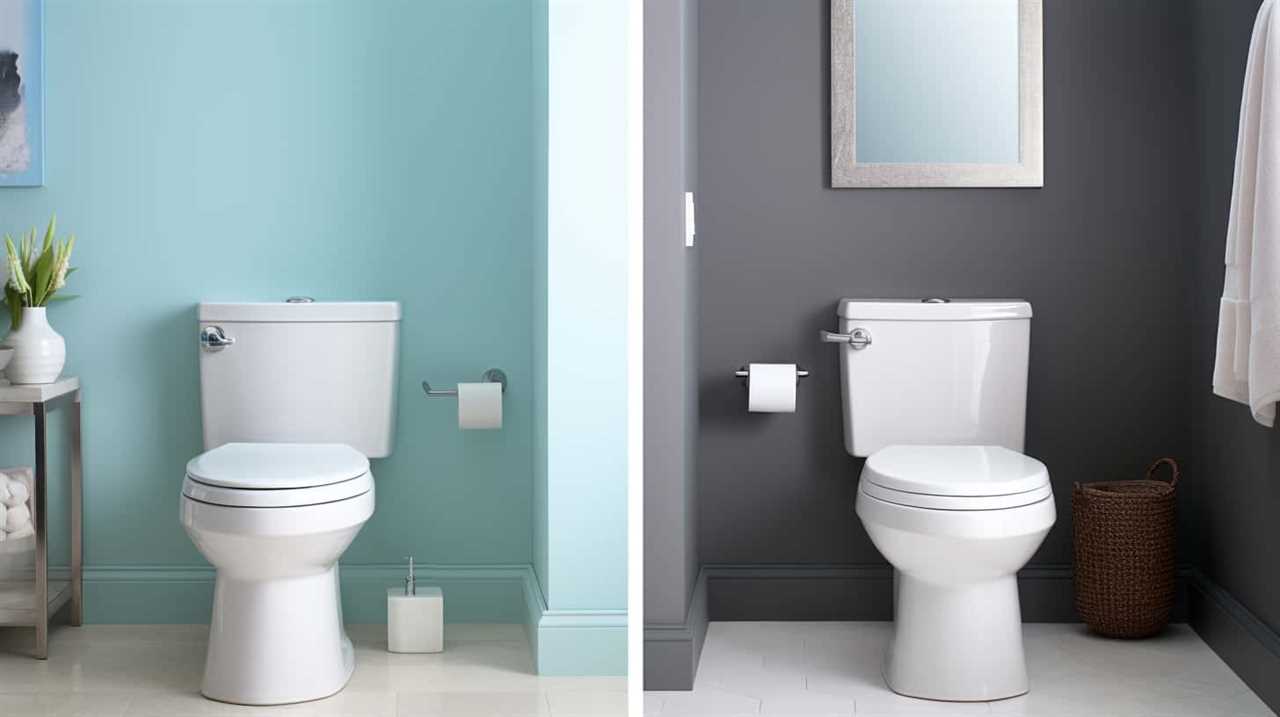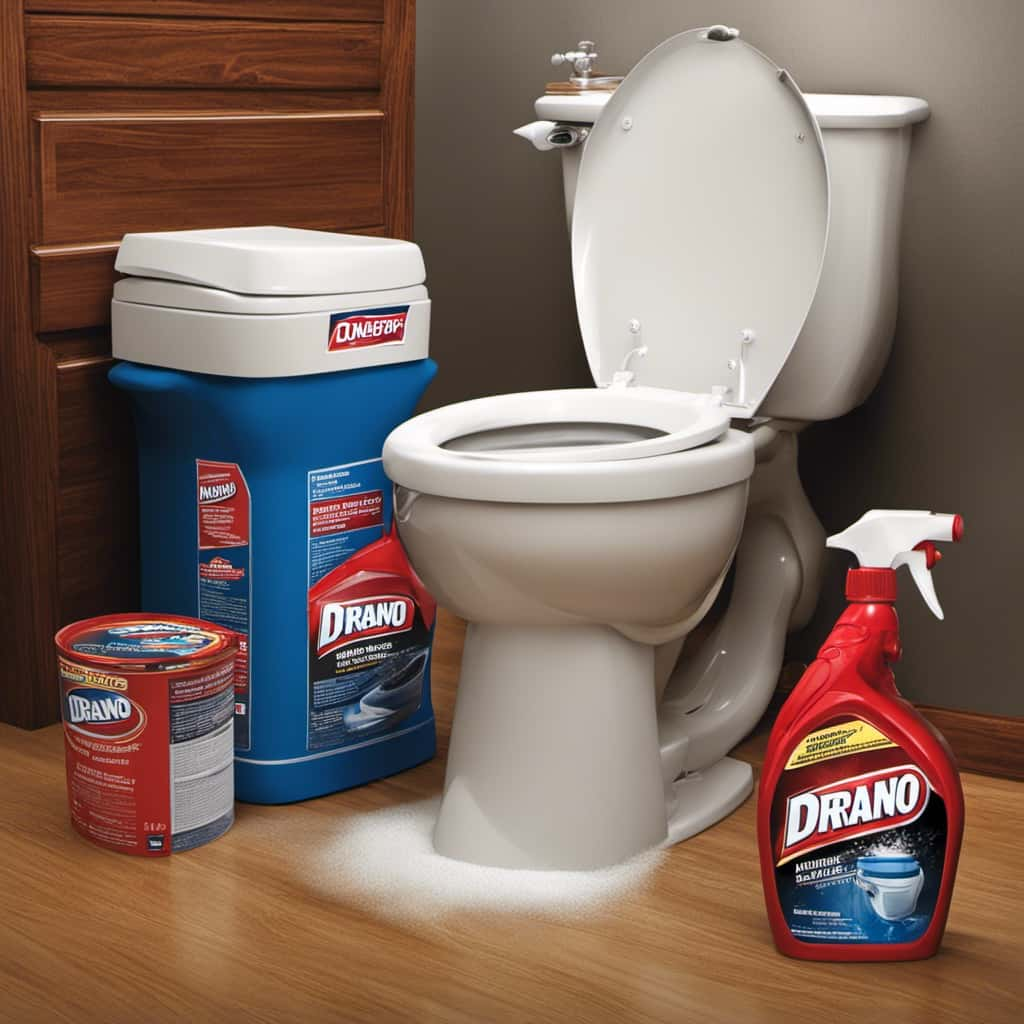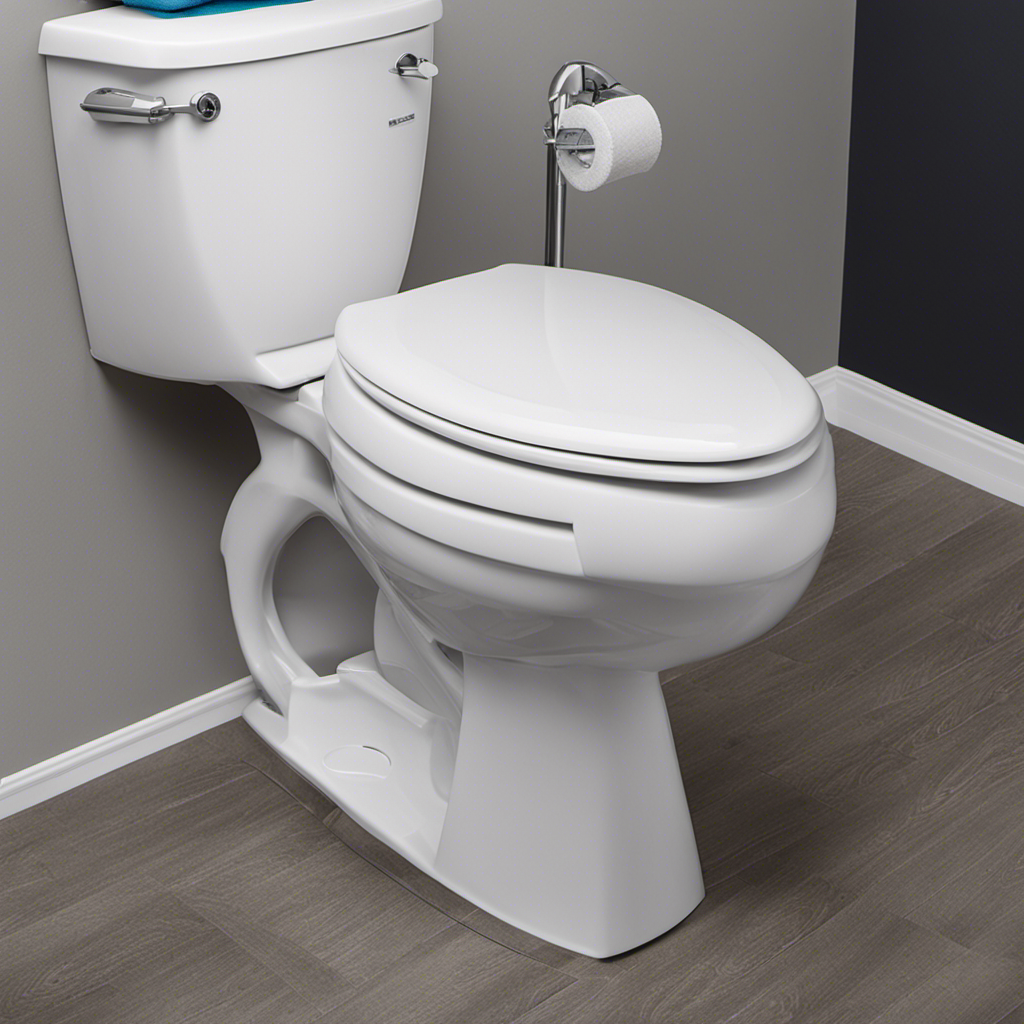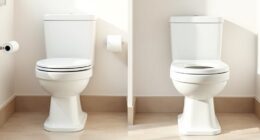- Hot water and dish soap vs. vinegar and baking soda
- Effectiveness of using a plunger vs. a toilet auger
Ever been stuck dealing with a blocked toilet? It’s an experience most of us have had, and it’s far from enjoyable. However, there’s no need to worry! In this article, we’re going to show you how to effectively unclog a toilet.
From using a plunger to homemade drain cleaners, we’ll provide you with practical solutions to tackle even the most stubborn clogs.
So, let’s dive in and become masters of unblocking toilets!
Key Takeaways
- Gather necessary supplies (plunger, gloves, towels, bucket)
- Assess the severity of the clog
- Use a plunger with a flange for a better seal
- Avoid common plunger mistakes
Gather Necessary Supplies
First, we gather the necessary supplies to unclog a toilet. It’s important to assess the severity of the clog before proceeding. To tackle most clogs, a plunger is the go-to tool. Make sure to choose a plunger with a flange, as it provides a better seal. Common plunger mistakes include not covering the entire drain opening or using too much force, which can cause water to splash out.

Additionally, wear gloves and have old towels or rags handy to clean up any mess. It’s also helpful to have a bucket or large container to hold water for flushing if needed. By gathering these supplies, we’re prepared to tackle the clog and restore proper flushing functionality to the toilet.
Now, let’s move on to assessing the severity of the clog.
Assess the Severity of the Clog
To accurately address the severity of the clog, we must evaluate the level of obstruction in the toilet drain. Here are five key factors to consider during the severity assessment:
- Water level: Observe the water level in the toilet bowl. If it’s close to overflowing, the clog may be severe.
- Flushing attempts: Determine if previous flushing attempts have been successful. If not, it could indicate a more challenging clog.
- Water drainage: Pay attention to how quickly or slowly the water drains from the toilet bowl. A slow drain could suggest a partial clog.
- Gurgling sounds: Listen for any gurgling sounds coming from the toilet or other drains. This could indicate a more significant blockage in the plumbing system.
- Backup in other fixtures: Check if other fixtures in the bathroom, such as sinks or showers, are experiencing drainage issues. This may suggest a larger plumbing problem.
Once you have assessed the severity of the clog, you can consider alternative solutions before resorting to using a plunger to unclog the toilet.

Use a Plunger to Unclog the Toilet
Let’s talk about using a plunger to unclog a toilet.
To effectively use a plunger, make sure to create a tight seal around the drain and apply firm, consistent pressure. Avoid common mistakes like using too much force, which can cause water to splash out, or not plunging long enough.
If a plunger doesn’t work, there are alternative methods you can try to unclog the toilet.
Proper Plunger Technique
To effectively unclog a toilet, we’ll need a plunger. Here are some tips for using a plunger properly:

- Choose the right plunger: Look for a plunger with a flange, as this design creates a better seal and increases effectiveness.
- Position the plunger correctly: Place the rubber cup of the plunger over the drain hole, ensuring a tight seal.
- Use steady, controlled force: Push down on the plunger firmly, then pull up quickly. Repeat this motion several times, maintaining a steady rhythm.
- Be patient: It may take several attempts before the clog is cleared, so don’t give up too soon.
- Practice good hygiene: After using the plunger, clean it thoroughly with hot water and disinfectant to prevent the spread of bacteria.
Common Mistakes to Avoid
When using a plunger to unclog a toilet, it’s important to avoid common mistakes that can hinder the effectiveness of the plunging process.
One common mistake isn’t using enough force when plunging. To effectively unclog a toilet, you need to use strong and consistent plunging motions.
Another mistake to avoid is using a plunger without creating a proper seal. Ensure that the rubber cup of the plunger completely covers the drain hole.
Additionally, it’s important to avoid using homemade remedies or chemicals to unclog the toilet before attempting to use a plunger. These remedies can sometimes worsen the blockage or damage the plumbing system.

Alternative Unclogging Methods
To effectively unclog a toilet, we can start by using a plunger. It’s a simple tool that creates a vacuum to dislodge the clog.
However, if you don’t have a plunger handy or want to try alternative methods, there are homemade drain cleaner alternatives and natural unclogging remedies that you can use. Here are five options to consider:
- Baking soda and vinegar: Mix equal parts of baking soda and vinegar, pour it into the toilet bowl, and let it sit for about 30 minutes. Then, flush the toilet to see if the clog has cleared.
- Hot water: Boil a pot of water and carefully pour it into the toilet bowl. The hot water can help break down the clog and push it through the pipes.
- Dish soap: Squirt a generous amount of dish soap into the toilet bowl and let it sit for a while. Then, pour hot water into the bowl and see if it helps to clear the clog.
- Wire hanger: Straighten a wire hanger and create a small hook at the end. Use it to manually break up the clog or push it through the pipes.
- Enzyme cleaner: Use a natural enzyme-based drain cleaner, following the instructions on the packaging. These cleaners can help break down organic matter and clear the clog.
Try Using a Toilet Auger
Now let’s talk about using a toilet auger to unclog a toilet.
The toilet auger is a tool that can be used when a plunger doesn’t work.

It works by using a long flexible cable with a corkscrew-like end to break up and remove the clog.
Auger Vs. Plunger
We prefer using a toilet auger over a plunger to clear clogs in our toilets. While a plunger can be effective in some cases, it requires regular maintenance and has its pros and cons. Here’s why we think a toilet auger is a better option:
- Deeper reach: A toilet auger can reach further into the pipes, ensuring that even stubborn clogs are cleared.
- Less mess: Unlike a plunger, a toilet auger doesn’t create a messy splashback, minimizing the clean-up required afterward.
- More control: With a toilet auger, you have better control over the amount of force applied, reducing the risk of damaging the toilet or pipes.
- Versatility: A toilet auger can be used for more than just unclogging toilets. It can also be used to clear clogs in sinks and tubs.
- Long-lasting: A well-maintained toilet auger can last for years, making it a worthwhile investment.
How to Use
Using a toilet auger to clear a clogged toilet is a straightforward process that can be done by anyone with a few simple steps.
First, make sure to wear gloves and protective eye gear for hygiene and safety.

Insert the auger into the toilet bowl, pushing it gently but firmly.
Rotate the handle clockwise to feed the cable into the drain.
Once you feel resistance, continue turning to break up the clog.
Pull the auger out slowly, being careful not to splash any wastewater.

Finally, flush the toilet to check if the clog has been successfully cleared.
Remember to clean and sanitize the auger before storing it away.
When to Call Professional
If the clog persists after attempting to clear it using a toilet auger, it may be time to consider calling a professional plumber for assistance. While using a toilet auger is a cost-effective solution to unclog a toilet, there are instances when a more complex issue may be at play. Here are some potential dangers and reasons why calling a professional plumber is the best course of action:
- Hidden blockages: A professional plumber has the expertise to identify and remove hidden blockages that may be causing the clog.
- Complex plumbing systems: Some homes have intricate plumbing systems that require specialized knowledge to diagnose and fix issues.
- Damage prevention: Calling a professional plumber can help prevent further damage to your toilet or plumbing system.
- Safety concerns: Dealing with plumbing issues can present potential dangers, such as exposure to harmful chemicals or risks of injury from improper handling of tools.
- Expert advice: A professional plumber can provide expert advice on how to maintain your toilet and prevent future clogs.
If the clog persists even after attempting to use a toilet auger, it’s time to consider calling a professional plumber. But before you do, let’s explore some cost-effective solutions you can try at home, such as creating a homemade drain cleaner.

Create a Homemade Drain Cleaner
To effectively unclog a toilet, one option is making a homemade drain cleaner. When faced with a clogged toilet, it’s important to explore homemade drain cleaner alternatives before resorting to harsh chemicals. Natural unclogging methods can be just as effective and are safer for both your health and the environment.
One simple homemade drain cleaner involves combining baking soda and vinegar. Start by pouring one cup of baking soda into the toilet bowl. Follow this by adding two cups of vinegar. The mixture will create a fizzing reaction that helps break down the clog. Allow it to sit for about 30 minutes before flushing the toilet. If the clog persists, you can try repeating the process or using a plunger to help dislodge the blockage.
Utilize Hot Water and Dish Soap
We can also try using hot water and dish soap to unclog a toilet. This method can be effective and easy to do.
Here are some discussion ideas comparing hot water and dish soap with vinegar and baking soda:

- Hot water and dish soap can help break down the clog, while vinegar and baking soda create a fizzing reaction that may not be as effective.
- Hot water and dish soap are readily available in most households, making them convenient options.
- Using a plunger is usually the first step when dealing with a clogged toilet, but if that doesn’t work, a toilet auger can be more effective in removing stubborn clogs.
Use a Wet/Dry Vacuum
When dealing with a clogged toilet, one effective option is using a wet/dry vacuum. A wet/dry vacuum is a versatile tool that can help remove the blockage and restore proper flushing. The vacuum works by creating suction, which can effectively pull out the debris causing the clog. One of the advantages of using a wet/dry vacuum is that it can handle both wet and dry materials, making it suitable for a variety of clogs.
However, there are a few alternatives to consider. For smaller clogs, a plunger or plumbing snake may be sufficient. Additionally, it’s important to note that using a wet/dry vacuum may require some caution, as improper use can lead to water damage or injury.
Now, let’s explore another method to unclog a toilet: try a baking soda and vinegar mixture.
Try a Baking Soda and Vinegar Mixture
Continuing from using a wet/dry vacuum, another effective method for unclogging a toilet is by trying a mixture of baking soda and vinegar. This homemade remedy isn’t only eco-friendly but also easy to use. Here are five steps to follow:

- Measure 1 cup of baking soda and pour it into the toilet bowl.
- Pour 2 cups of vinegar into the bowl, making sure to cover the baking soda.
- Let the mixture sit for about 30 minutes, allowing it to fizz and break down the clog.
- Use a toilet brush to gently scrub the mixture around the bowl.
- Finally, flush the toilet to see if the clog has cleared.
By using this combination of baking soda and vinegar, you can often clear minor clogs without the need for harsh chemicals.
However, if the clog persists, it’s time to move on to the next method: using a wire hanger as a makeshift snake.
Use a Wire Hanger as a Makeshift Snake
To clear a clogged toilet, grab a wire hanger and use it as a makeshift snake. If you don’t have a toilet auger at hand, a wire hanger can be a great alternative. Here’s how you can use it effectively.
- Straighten the hanger and bend one end into a hook shape.
- Insert the hooked end into the toilet drain and gently push it in.
- Rotate the hanger clockwise and counterclockwise to dislodge the clog. Be careful not to scratch the porcelain.
- Once you feel resistance, slowly pull out the hanger, hopefully bringing the clog with it.
- Remember to dispose of any waste properly.
If this method doesn’t work, you can try using homemade drain cleaner recipes as an additional solution.

Use a Chemical Drain Cleaner Cautiously
When it comes to unclogging a toilet, using a chemical drain cleaner may seem like a quick and easy solution. However, it’s important to use these products cautiously.
There are safe alternatives to consider, as chemical drain cleaners can pose potential health risks and may require proper disposal methods.
Safe Alternatives for Chemicals
We prefer using safe alternatives for chemicals in unclogging a toilet, such as using a chemical drain cleaner cautiously. When it comes to maintaining a clean and functional toilet, there are several eco-friendly options that can effectively clear a clog without resorting to harsh chemicals. Here are five safe alternatives to consider:
- Plunger: A tried-and-true method that creates pressure to dislodge the clog.
- Boiling water: Pouring hot water down the toilet can help break up the blockage.
- Baking soda and vinegar: This natural combination creates a chemical reaction that can loosen the clog.
- Toilet auger: A specialized tool designed to break up stubborn clogs.
- Enzyme-based cleaners: These cleaners use natural enzymes to break down organic matter without harming the environment.
Potential Health Risks
Using a chemical drain cleaner cautiously can pose potential health risks. While these products may effectively unclog your toilet, they contain harsh chemicals that can be harmful if not handled properly. It is important to be aware of the potential long term effects of using chemical drain cleaners and take necessary precautions. Regular maintenance and prevention are key to avoiding clogged toilets and the need for chemical drain cleaners. By practicing good toilet habits and implementing simple maintenance tasks, such as using a plunger or drain snake, you can keep your toilet in good working condition. Additionally, scheduling regular plumbing inspections can help identify and address any potential issues before they become major problems. By prioritizing regular maintenance and being mindful of the potential health risks, you can ensure a healthier and more efficient toilet system for your home.

| Potential Long Term Effects | Importance of Regular Maintenance |
|---|---|
| Chemical exposure leading to health issues | Prevents clogs and blockages |
| Environmental impact from chemical residue | Detects and repairs leaks |
| Respiratory problems from inhalation | Ensures proper functioning |
| Skin irritations and burns | Increases overall lifespan |
| Damage to plumbing system | Reduces the need for repairs |
Proper Disposal Methods?
To properly dispose of a chemical drain cleaner, it’s important to follow safe handling guidelines and take precautions to prevent harm to ourselves and the environment. Here are some proper disposal methods to consider:
- Read the product label carefully for specific instructions on how to dispose of the chemical drain cleaner.
- Check with your local waste management facility to see if they accept chemical drain cleaners for disposal. If they do, follow their guidelines for drop-off or collection.
- Never pour the chemical drain cleaner down the sink, toilet, or storm drains as it can contaminate water sources and harm aquatic life.
- Consider using alternative methods to unclog your toilet, such as a plunger or a drain snake, to avoid the use of chemical drain cleaners altogether.
- If you must dispose of the chemical drain cleaner in your household trash, double-bag it to prevent leaks and keep it out of reach of children.
Now that we know how to properly dispose of the chemical drain cleaner, let’s move on to the next step: removing and cleaning the toilet trap.
Remove and Clean the Toilet Trap
To unclog a toilet, one option is to take out and thoroughly clean the toilet trap. Maintaining the toilet trap is essential for preventing clogs effectively.
The toilet trap is a curved pipe located at the base of the toilet bowl that prevents sewer gases from entering the bathroom. Over time, debris like toilet paper, hair, or even small objects can accumulate in the trap and cause blockages.

To clean the toilet trap, start by turning off the water supply to the toilet and flushing it to empty the bowl. Then, use a wrench to loosen the nuts that hold the trap in place and carefully remove it. Clean the trap using a toilet brush or a plumbing snake, making sure to remove any stuck debris.
Once cleaned, reattach the trap and turn the water supply back on. If the clog persists after cleaning the trap, consider calling a professional plumber for further assistance.
Consider Calling a Professional Plumber
If the clog persists after cleaning the trap, we recommend considering calling a professional plumber for further assistance. While there are several do-it-yourself methods that can be effective in unclogging a toilet, sometimes the issue may require the expertise of a professional.
Here are a few reasons why calling professionals can be beneficial:

- Experience: Plumbers have the knowledge and experience to accurately diagnose and resolve complex clogs.
- Specialized Tools: Professionals have access to specialized tools and equipment that can effectively clear stubborn clogs.
- Time-Saving: Hiring a plumber can save you time and effort, allowing you to focus on other tasks.
- Preventing Damage: Incorrectly attempting to fix a clog can potentially cause further damage to your toilet or plumbing system.
- Long-Term Solutions: Plumbers can provide long-term solutions to prevent future clogs and ensure the proper functioning of your toilet.
Considering these aspects, reaching out to a professional plumber can be a wise decision when dealing with persistent toilet clogs.
Prevent Future Toilet Clogs
One effective way to prevent future toilet clogs is regular maintenance. By taking proper care of your toilet, you can avoid the inconvenience and potential health risks associated with clogged toilets.
Regular maintenance includes simple tasks such as flushing only toilet paper and human waste down the toilet, avoiding flushing items like wipes, sanitary products, and excessive amounts of toilet paper.
Additionally, using homemade drain cleaner alternatives can help prevent clogs without the health risks associated with chemical drain cleaners. For example, a mixture of baking soda and vinegar can be poured down the toilet to break down buildup and keep the pipes clear.

Regularly inspecting and cleaning the toilet tank and bowl can also help prevent clogs by removing any potential obstructions.
Frequently Asked Questions
What Supplies Do I Need to Gather Before Attempting to Unclog a Toilet?
Before attempting to unclog a toilet, we need to gather necessary supplies. These include a plunger, rubber gloves, and a bucket. Assess the severity of the clog and use the plunger effectively to resolve the issue.
How Can I Assess the Severity of a Clogged Toilet?
When assessing toilet clogs, it’s important to look for signs of severe clogs, such as water not draining or rising rapidly. These indicators can help determine the severity of the blockage and guide the appropriate action.
Can a Plunger Effectively Unclog a Toilet?
Yes, a plunger can effectively unclog a toilet without causing damage. However, if the clog persists, there are alternative methods such as using a toilet auger or a mixture of baking soda and vinegar.

What Is a Toilet Auger and How Do I Use It?
A toilet auger is a useful tool that helps to unclog toilets. It has benefits such as being effective and easy to use. If you don’t have a toilet auger, there are alternatives like using a plunger.
Are There Any Homemade Drain Cleaners That Can Be Used to Unclog a Toilet?
There are homemade drain cleaners that can be used to unclog a toilet, but they may not be as effective as commercial ones. Some natural remedies include using baking soda and vinegar or a mixture of hot water and dish soap.
Conclusion
In conclusion, dealing with a clogged toilet can be a frustrating experience. However, with the right tools and techniques, you can quickly and effectively unclog your toilet.
Remember to assess the severity of the clog, use a plunger or toilet auger, and consider making a homemade drain cleaner.

If all else fails, don’t hesitate to call in a professional plumber.
With these tips, you’ll be able to tackle toilet clogs like a pro and prevent future mishaps.
So go ahead and flush those clogs away!










